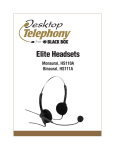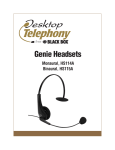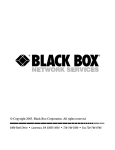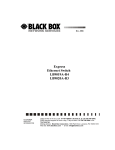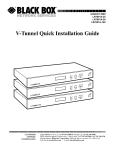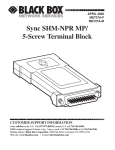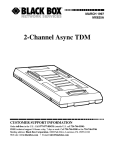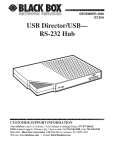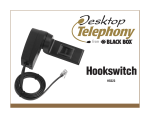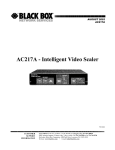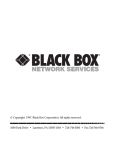Download Computer Headset
Transcript
Computer Headset HS500A FCC INFORMATION FEDERAL COMMUNICATIONS COMMISSION AND INDUSTRY CANADA RADIO FREQUENCY INTERFERENCE STATEMENTS This equipment generates, uses, and can radiate radio frequency energy and if not installed and used properly, that is, in strict accordance with the manufacturer’s instructions, may cause interference to radio communication. It has been tested and found to comply with the limits for a Class A computing device in accordance with the specifications in Subpart J of Part 15 of FCC rules, which are designed to provide reasonable protection against such interference when the equipment is operated in a commercial environment. Operation of this equipment in a residential area is likely to cause interference, in which case the user at his own expense will be required to take whatever measures may be necessary to correct the interference. Changes or modifications not expressly approved by the party responsible for compliance could void the user’s authority to operate the equipment. This digital apparatus does not exceed the Class A limits for radio noise emission from digital apparatus set out in the Radio Interference Regulation of Industry Canada. Le présent appareil numérique n’émet pas de bruits radioélectriques dépassant les limites applicables aux appareils numériques de classe A prescrites dans le Règlement sur le brouillage radioélectrique publié par Industrie Canada. 1 COMPUTER HEADSET FCC REQUIREMENTS FOR TELEPHONE-LINE EQUIPMENT 1. The Federal Communications Commission (FCC) has established rules which permit this device to be directly connected to the telephone network with standardized jacks. This equipment should not be used on party lines or coin lines. 2. If this device is malfunctioning, it may also be causing harm to the telephone network; this device should be disconnected until the source of the problem can be determined and until the repair has been made. If this is not done, the telephone company may temporarily disconnect service. 3. If you have problems with your telephone equipment after installing this device, disconnect this device from the line to see if it is causing the problem If it is, contact your supplier or an authorized agent. 4. The telephone company may make changes in its technical operations and procedures. If any such changes affect the compatibility or use of this device, the telephone company is required to give adequate notice of the changes. 2 FCC INFORMATION 5. If the telephone company requests information on what equipment is connected to their lines, inform them of: a. The telephone number that this unit is connected to. b. The ringer equivalence number. c. The USOC jack required: RJ-11C. d. The FCC registration number. Items (b) and (d) can be found on the unit’s FCC label. The ringer equivalence number (REN) is used to determine how many devices can be connected to your telephone line. In most areas, the sum of the RENs of all devices on any one line should not exceed five (5.0). If too many devices are attached, they may not ring properly. 6. In the event of an equipment malfunction, all repairs should be performed by your supplier or an authorized agent. It is the responsibility of users requiring service to report the need for service to the supplier or to an authorized agent. 3 COMPUTER HEADSET CERTIFICATION NOTICE FOR EQUIPMENT USED IN CANADA The Canadian Department of Communications label identifies certified equipment. This certification means that the equipment meets certain telecommunicationsnetwork protective, operation, and safety requirements. The Department does not guarantee the equipment will operate to the user’s satisfaction. Before installing this equipment, users should ensure that it is permissible to be connected to the facilities of the local telecommunications company. The equipment must also be installed using an acceptable method of connection. In some cases, the company’s inside wiring associated with a single-line individual service may be extended by means of a certified connector assembly (extension cord). The customer should be aware that compliance with the above conditions may not prevent degradation of service in some situations. Repairs to certified equipment should be made by an authorized Canadian maintenance facility—in this case, your supplier. Any repairs or alterations made by the user to this equipment, or equipment malfunctions, may 4 CDC NOTICE give the telecommunications company cause to request the user to disconnect the equipment. Users should ensure for their own protection that the electrical ground connections of the power utility, telephone lines, and internal metallic water pipe system, if present, are connected together. This precaution may be particularly important in rural areas. 5 COMPUTER HEADSET NORMAS OFICIALES MEXICANAS (NOM) ELECTRICAL SAFETY STATEMENT INSTRUCCIONES DE SEGURIDAD 1. Todas las instrucciones de seguridad y operación deberán ser leídas antes de que el aparato eléctrico sea operado. 2. Las instrucciones de seguridad y operación deberán ser guardadas para referencia futura. 3. Todas las advertencias en el aparato eléctrico y en sus instrucciones de operación deben ser respetadas. 4. Todas las instrucciones de operación y uso deben ser seguidas. 5. El aparato eléctrico no deberá ser usado cerca del agua—por ejemplo, cerca de la tina de baño, lavabo, sótano mojado o cerca de una alberca, etc.. 6. El aparato eléctrico debe ser usado únicamente con carritos o pedestales que sean recomendados por el fabricante. 7. El aparato eléctrico debe ser montado a la pared o al techo sólo como sea recomendado por el fabricante. 8. Servicio—El usuario no debe intentar dar servicio al equipo eléctrico más allá a lo descrito en las instrucciones de operación. Todo otro servicio deberá ser referido a personal de servicio calificado. 9. El aparato eléctrico debe ser situado de tal manera que su posición no interfiera su uso. La colocación del aparato eléctrico sobre una cama, sofá, alfombra o superficie similar puede bloquea la ventilación, no se debe colocar en libreros o gabinetes que impidan el flujo de aire por los orificios de ventilación. 6 NOM STATEMENT 10. El equipo eléctrico deber ser situado fuera del alcance de fuentes de calor como radiadores, registros de calor, estufas u otros aparatos (incluyendo amplificadores) que producen calor. 11. El aparato eléctrico deberá ser connectado a una fuente de poder sólo del tipo descrito en el instructivo de operación, o como se indique en el aparato. 12. Precaución debe ser tomada de tal manera que la tierra fisica y la polarización del equipo no sea eliminada. 13. Los cables de la fuente de poder deben ser guiados de tal manera que no sean pisados ni pellizcados por objetos colocados sobre o contra ellos, poniendo particular atención a los contactos y receptáculos donde salen del aparato. 14. El equipo eléctrico debe ser limpiado únicamente de acuerdo a las recomendaciones del fabricante. 15. En caso de existir, una antena externa deberá ser localizada lejos de las lineas de energia. 16. El cable de corriente deberá ser desconectado del cuando el equipo no sea usado por un largo periodo de tiempo. 17. Cuidado debe ser tomado de tal manera que objectos liquidos no sean derramados sobre la cubierta u orificios de ventilación. 18. Servicio por personal calificado deberá ser provisto cuando: A: El cable de poder o el contacto ha sido dañado; u B: Objectos han caído o líquido ha sido derramado dentro del aparato; o C: El aparato ha sido expuesto a la lluvia; o D: El aparato parece no operar normalmente o muestra un cambio en su desempeño; o E: El aparato ha sido tirado o su cubierta ha sido dañada. 7 COMPUTER HEADSET TRADEMARKS USED IN THIS MANUAL SoundBlaster® is a registered trademark of Creative Labs, Inc. Windows® is a registered trademark of Microsoft Corporation. Any other trademarks mentioned in this manual are acknowledged to be the property of the trademark owners. 8 CONTENTS Contents 1. Specifications . . . . . . . . . . . . . . . . . . . . . . . . . . . 10 2. Introduction. . . . . . . . . . . . . . . . . . . . . . . . . . . . 11 2.1 Description. . . . . . . . . . . . . . . . . . . . . . . . . . 11 2.2 Features . . . . . . . . . . . . . . . . . . . . . . . . . . . . 11 3. Installation . . . . . . . . . . . . . . . . . . . . . . . . . . . . . 12 3.1 Option A: Over-the-Head . . . . . . . . . . . . . . 12 3.2 Option B: On-the-Ear . . . . . . . . . . . . . . . . . 14 4. Operation: Sound-Level Settings . . . . . . . . . . . 16 9 COMPUTER HEADSET 1. Specifications Transmit: Frequency Response — 100 to 5500 Hz ±4 dB Microphone — Noise-canceling unidirectional electret Sensitivity — -46 dBV/Pa @ 1 kHz with 2.2 Kohm load Power — Current consumption: <300 µa; Operating voltage: 1.5 to 10 volts Receive: Frequency Response — 250 to 4000 Hz Speaker — 32 ohms General: Weight — 1.4 oz. (39.7 g) 10 CHAPTER 2: Introduction 2. Introduction 2.1 Description The Computer Headset is the ideal headset for any PC application—speech recognition, computer telephony, or Internet telephony. 2.2 Features • Two styles available: on-the-ear or over-the-head. • Noise-canceling microphone with flexible boom. • Compatible with SoundBlaster® PC cards. 11 COMPUTER HEADSET 3. Installation 3.1 Option A: Over-the-Head Figure 3-1. Over-the-Head. Figure 3-2. Over-the-Head: Right Ear. 12 CHAPTER 3: Installation Figure 3-3. Over-the-Head: Left Ear. 1/2" (12 mm) Figure 3-4. Over-the-Head. 13 COMPUTER HEADSET 3.2 Option B: On-the-Ear For use on right ear For use on left ear Figure 3-5. On-the-Ear: Step 1. 1/2 " (12 mm) Figure 3-6. On-the-Ear: Step 2. 14 CHAPTER 3: Installation For use with a PC Figure 3-7. Connecting to the Computer. 15 COMPUTER HEADSET 4. Operation: Sound Level Settings Computer sound cards can create extremely loud output when used through a headset. Although the Computer Headset has some built-in safety features, please take the following precautions. 1. Before you use your Computer Headset, set the volume control on your computer to low/mid level. Test the level by holding the headset near your ear and adjusting the volume. In Windows ® 95, look under Start—Settings—Control Panels— Multimedia. 2. Set the modem volume level (if applicable) to a low setting to avoid loud bursts when connecting. In Windows 95, look under Start—Settings— Control Panels—Modems—Properties. NOTE Some multimedia and communication software applications have their own volume controls. These may override the Windows 95 settings. Check with your software owner’s manual. 16 CHAPTER 5: Troubleshooting 5. Troubleshooting 5.1 Calling Black Box If you determine that your Computer Headset is malfunctioning, do not attempt to alter or repair the unit. It contains no user-serviceable parts. Contact Black Box at 724-746-5500. Before you do, make a record of the history of the problem. We will be able to provide more efficient and accurate assistance if you have a complete description, including: • the nature and duration of the problem. • when the problem occurs. • the components involved in the problem. • any particular application that, when used, appears to create the problem or make it worse. 17 COMPUTER HEADSET 5.2 Shipping and Packaging If you need to transport or ship your Computer Headset: • Package it carefully. We recommend that you use the original container. • If you are shipping the Computer Headset for repair, make sure you include everything that came in the original package. Before you ship, contact Black Box to get a Return Materials Authorization (RMA) number. 18 CUSTOMER SUPPORT INFORMATION Order toll-free in the U.S.: Call 877-877-BBOX (outside U.S. call 724-746-5500) FREE technical support 24 hours a day, 7 days a week: Call 724-746-5500 or fax 724-746-0746 Mailing address: Black Box Corporation, 1000 Park Drive, Lawrence, PA 15055-1018 Web site: www.blackbox.com • E-mail: [email protected] © Copyright 2000. Black Box Corporation. All rights reserved. 54-0200A June 2000 Printed in USA





















